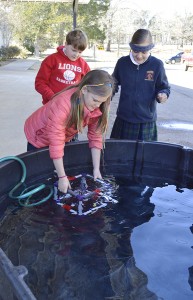
Regents School fourth-graders Olivia Mogridge (left), James Leister and Natalie Prather test their model ROV in a vat of water at the school. Photo by Michelle Edwards
OXFORD, Miss. – Nothing excites kids like robots, except maybe getting to build and operate one. That’s exactly what lucky fourth-graders at Regents School of Oxford enjoyed recently when specialists from the National Institute for Undersea Science and Technology visited their classroom.
NIUST is a collaboration between the University of Mississippi and the University of Southern Mississippi that studies the deep sea using advanced technologies. NIUST teamed up with the national RETINA educational program, which provides opportunities for K-6 grade students to learn about the ocean through the technologies that make these studies possible.
The activity at Regents School centered on a hands-on experience for the kids. After learning about the Deepwater Horizon incident and deep-sea corals, the young explorers were exposed to ROVs, remotely operated vehicles, used for undersea applications. Teams of four students built an ROV using parts supplied by NIUST. After working together on their designs, students chose parts from bins that held different lengths of PVC pipes, PVC fittings and floats for the ROV frame.
“The fourth-grade students at Regents School of Oxford had a blast working in groups creating and building remote operational vehicles,” said Tracy Knox, fourth-grade teacher at Regents. “Their enthusiasm in learning about the corals in the Gulf and how these filter feeders were affected by the oil spill was only the beginning of an afternoon of fun activity. The students were able to remotely operate their created vehicles in a huge tank of water and their sense of accomplishment in watching their ROVs roam through the water was amazing.
“As a teacher, this is the kind of engagement in learning that we aspire to achieve. I am so thankful our fourth-graders were able to participate in this program.”
Once the frame was built, students attached three battery-powered thrusters to propel their ROVs. After attaching the batteries, they were off to the tubs of water to see how their designs worked. Could they turn right and left, and could they go up and down in the water?
The room was filled with shouts, laughter, splashing and reworking of designs, but mostly, the students were learning while having a lot of fun
“We like to introduce kids to science and engineering,” said Geoff Wheat, NIUST director. “These are two fields that need more graduates. Our approach is to get the kids involved in real-world experiences through hands-on, team-building experiences with technology-based problems. The kids really light up with hands-on problem-solving activities.”
The UM Center for Mathematics and Science Education helped with the event, which fits perfectly with the center’s mission to improve mathematics and science education in Mississippi and promoting interest in science, technology, engineering and mathematics fields, said Susan Peterson, the center’s K-12 STEM outreach coordinator.
“When we were asked to help coordinate this event, we were more than willing to jump on board,” Peterson said. “This was our first exposure to this particular type of robotic activity. It is a perfect fit for our mission, and we are excited to be of assistance in the future.”
For information on booking this program for your fourth-grade class, contact Michelle Edwards, NIUST assistant to the director for marketing and business development, at edwardsm@olemiss.edu.
“We also want to expose kids of all ages to this activity and to the environment of the deep sea,” Edwards said. “Look for us at the Grove during home football games.”
Funding for this activity was supported by ECOGIG, a consortia funded by the Gulf of Mexico Research Initiative and headquartered at the UM Field Station.